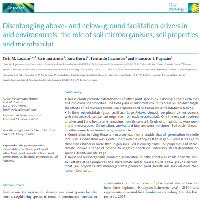Resumen
- Nurse plants promote establishment of other plant species by buffering climate extremes and improving soil properties. Soil biota plays an important role, but an analysis to disentangle the effects of soil microorganisms, soil properties and microclimate on facilitation is lacking. In three microhabitats (gaps, small and large Retama shrubs), we placed six microcosms with sterilized soil, two per soil origin (i.e. from each microhabitat). One in every pair received an alive, and the other a sterile, inoculum from its own soil. Seeds of annual plants were sown into the microcosms. Germination, survival and biomass were monitored. Soil bacterial communities were characterized by pyrosequencing. Germination in living Retama inoculum was nearly double that of germination in sterile inoculum. Germination was greater under Retama canopies than in gaps. Biomass was up to three times higher in nurse than in gap soils. Soil microorganisms, soil properties and microclimate showed a range of positive to negative effects on understory plants depending on species identity and life stage. Nurse soil microorganisms promoted germination, but the effect was smaller than the positive effects of soil properties and microclimate under nurses. Nurse below-ground environment (soil properties and microorganisms) promoted plant growth and survival more than nurse microhabitat.
